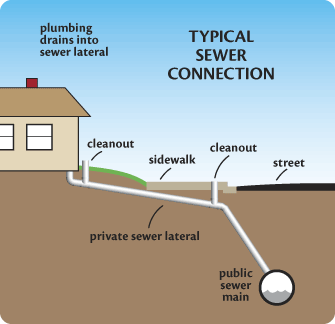December 1, 2015
These new guidelines apply only to homes that are attached to a sewer system. The Ojai Valley Sanitation District (OVSD) has mandated that any home that goes into escrow from December 1st forward have a lateral sewer line inspection. What is a lateral sewer line? It consists of pipes that carry waste water from your home and tie into the main sewer line that runs along the street (see picture below). The OVSD is responsible for the care and maintenance of the main sewer line; the homeowner is responsible for the lateral line that runs from their home out to the street.

What You Need to Know
- The average cost of the lateral line inspection is $250 – $300 and requires that a permit be pulled for the inspection (an additional $75). In most cases, you will hire a plumber who will pull the permit as part of the inspection process.
- During the inspection an OVSD inspector also needs to be there to confirm it’s being done properly.
- The plumber will run a camera through the sewer line, recording it to DVD. This will be submitted along with the inspection form.
- If there are no defects, the OVSD will issue a Compliance Certificate that’s good for 10 years. A re-inspection will be required every 10 years thereafter.
- Homes that are not for sale do not fall under this requirement, nor do they need to get an inspection of their lateral lines every 10 years. The sale of the home is what triggers the inspections and subsequent 10-year follow-up inspections.
- If there ARE defects in the lines the OVSD will issue a Defects Letter and the repairs must be completed within 6 months. How much damage there is to the sewer line will effect the length of time for which they’ll issue a Compliance Certificate. For example, if there are minor tree roots invading the sewer lines – after treatment or repairs they may only issue a Compliance Certificate that’s good for 2 or 3 years.
- If a “patch repair” is required (usually due to broken or cracked lines), the maximum length of time that they’ll issue the Compliance Certificate for is 5 years.
- In order to properly inspect the lateral sewer lines, there must be a “cleanout” from which the plumber can run their camera through. If a home does not have a cleanout, the cost to have one put in runs from $700 to $1,000. In some cases the plumber might be able to pull a toilet from the house and run the camera from there.
As of the day of our meeting with Jeff Palmer from the OVSD (about 2 weeks ago), roughly 30% of the lateral sewer lines they’ve inspected thus far have required some sort of root removal or repair. If that holds true, for most homeowners this won’t be an issue.
If it’s discovered during the course of escrow – via inspection – that the sewer lines need repair, this is an item of negotiation between buyer and seller. We have no way to predict how this is going to pan out in the coming years. Will the homeowner take on the cost to repair? Or will buyers agree to split the cost with the homeowners? As of right now, there no “customary” way of dealing with these costs.
Items of concern:
- The homeowner may have to shell out as much as $1,300 just to have the initial inspection performed (if they have to pay for a cleanout to be installed). This inspection should be performed before the homeowner puts their home on the market – so that they know whether or not there’s an issue before the home goes into escrow. Unfortunately, this is a cost that cannot be paid through escrow; it comes out of the homeowner’s pocket.
- If the buyer of a listed home is procuring a loan to pay for the sale, it’s very likely that lenders are going to require that any work on damaged sewer lines be completed before they’ll issue the funds for the loan (which would allow the sale to close). This could delay escrows significantly.
Finally, some of the current guidelines were created quickly, with several revisions as the December 1st deadline loomed. We think it’s safe to assume that the rules of the game may change over time. Make sure that you and your Realtor/broker are up to speed on these items. It could mean the difference between a smooth sale or substantial headaches (not to mention potential litigation).
![]()